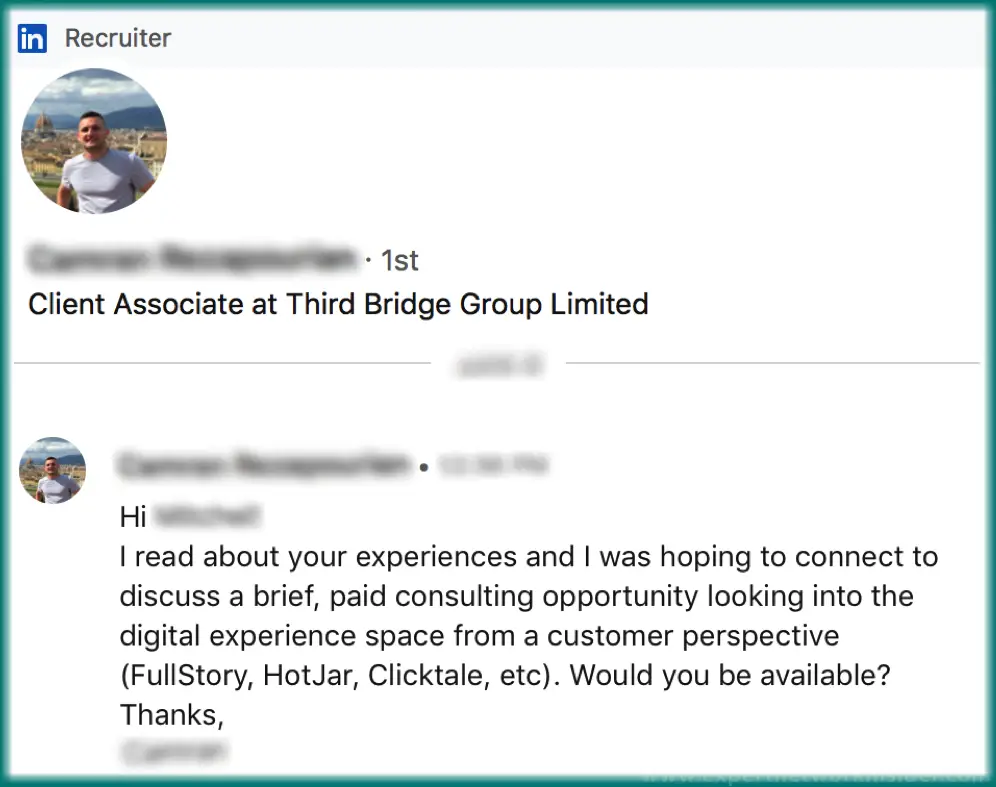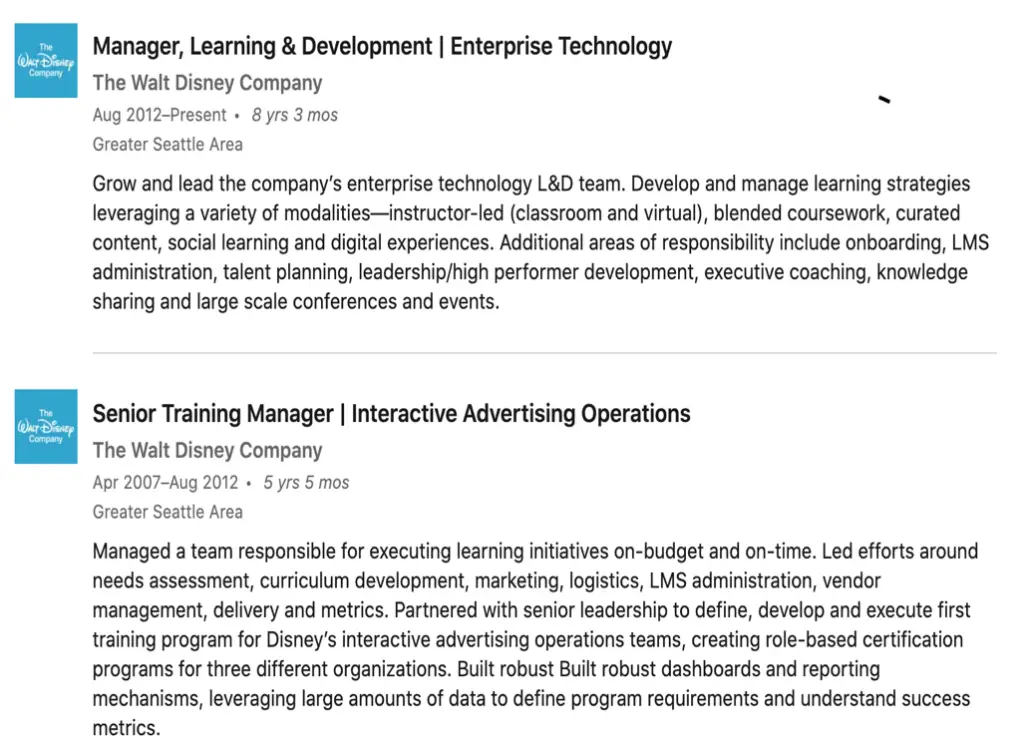Getting Started With Expert Network Consulting

Looking for the real secrets to success with expert networks? We asked employees at major expert networks and their leading consultants to share the inside scoop on becoming in-demand expert. A recruiter at Third Bridge shares a behind-the-scenes look at how to establish yourself and land your first projects with a new expert network.
You’ve been approached to do short term consulting through an expert network. Whether you have your doubts about participating in the industry or if you have done a few consultations already and are looking to do more, expert network consulting is an extremely profitable side gig that is accessible to anyone. Who doesn’t enjoy being the star of 30 – 60 minute phone discussions with clients from around the world who are willing to pay top dollar for your knowledge?

As a recruiter for Third Bridge, I recruit specialists (expert consultants) for an average of 15 projects every week. Most times, many new recruits feel insecure about their intrinsic value because they aren’t a CEO at a Fortune 500 company. The reality is that while I have done projects with C-level executives at Google, Apple, and Facebook, I have done even more projects with veterinarians, category buyers and nurses. So here are a my insider tips and tricks to earning your first few dollars or even expanding this income stream.
How does an expert network project begin?

A large majority of projects are an expert network’s clients looking into a target company, whether to help with an ongoing internal issue or to decide if it is worth acquiring. These clients are typically a private equity firm, a management consulting firm helping a corporate client, or a management consulting firm trying to identify attractive businesses for future engagements. In order to do so, the client needs to speak with currents and formers at the target company, competitors in the space and customers of the target company. The number of consultations vary between projects: 5 – 20 calls if the client is doing an RFP to win the projects and more than 50 calls if the client has won the project and needs to do strategy work. The breakdown of calls among the three categories is decided ultimately by the client.
Once a client begins a project, they send out a brief to their top 2 – 3 favorite expert network companies to schedule their first consultations. These expert networks will first use their internal database of available consultants and send over an initial list to the client with the hopes of covering as many consultations required by the client. If the client does not like these first group of consultants or needs more consultants than the ones listed, expert networks begin custom recruiting for new consultants. For instance, if a client requests for 10 consultations for their project and select 6 in-network consultants, new consultants are sourced to meet the remaining ask of 4 consultations. So how do you increase your chances of getting paid consultations?
>>> Click here to register as a GLG Council Member and start receiving project opportunities.
How to get noticed by an expert network
These expert networks use LinkedIn, The Ladders and Monster as their primary means of identifying potential consultants. The Ladders is a website for white collar workers to upload their resumes for employment opportunities, and Monster is for blue collar workers to do the same. Expert network recruiters, such as myself, spend our entire work day sieving through an endless number of profiles to identify promising candidates. Due to our tight deadlines (as most projects only last just over a week), we prioritize profiles we know would be a good fit for the project and solicit a quick response. In order for you to up your chances of being reached out to, you should ensure that your employment history is up-to-date, your companies are associated with the LinkedIn approved ones (not misspelled or manually entered), and you have a description of your expertise.
For instance, a client wants to speak to someone at Disney who procures Learning & Development software and can discuss LMS vendors. An expert network recruiter will set the search to only “The Walt Disney Company” and keyword “Learning & Development”. Hence, if you are currently employed with Disney but you have misspelled your company name or you’re using another variety of the Disney name, you are cut from this first process. Needless to say, if you are currently involved in Learning & Development or LMS but did not include it in your LinkedIn profile, your profile will not be shortlisted as well.
Now, let’s take a look at two similar LinkedIn profiles that come up with these search settings.
Profile #1:

Profile #2:

Keeping the client’s brief in mind, profile #2 is clearly the winner. Even though both profiles have a manager title, it’s clear that the person with profile #2 does the decision making when it comes to LMS solutions. In fact, profile #2 will appear for a variety of different recruitment searches for projects spanning from operations to data management. As expert network recruiters have limited time, they will always choose the profile that clearly matches their client’s brief rather than take a gamble on an ambiguous profile that may be who they are looking for. After all, the larger your company, the larger the pool of people who will have identical roles as yourself. So be descriptive on your LinkedIn profile!
Pro-tip: Many people want to be recruited for these consulting engagements, but ironically, make it extremely difficult for recruiters to contact them. Things like requiring an email to send you a connection or providing no contact information on your LinkedIn profile will slow a recruiter’s process, making the decision easy to skip over your profile for another similar profile that guarantees a quick response.
Work with multiple expert networks
Getting active with multiple expert networks is one of the best ways to expand the volume of opportunities you’re invited to apply for. Expert networks often have an overlap in clients, but there’s also a high chance they have their own unique clients. Instead of working exclusively with just one expert network, you should aim to set up a profile with as many expert networks as possible to expand your consulting chances. Contrary to how expert networks market themselves, there is no selective invite to join. Instead, it is in an expert network’s best interest to have a huge network of readily available consultants to meet a client’s request as quickly as possible (and to beat out the other networks).
I often get concerns that a consultant doesn’t want the client to receive his name from 3 expert networks, and this is often attributed to the fear of making themselves look bad to the client. The truth is, this is a transactional business and clients often read the blurb describing your experiences rather than fixate on your name and where you may work at. In addition, clients are aware that the best consultants are on many different networks. Read: the client doesn’t care, and neither should you! These clients are prioritizing hitting their consultation targets and you are prioritizing getting those consultations, so it’s a win-win.
You should respond to every single consulting request even if you have a hunch they are for the same project. This is because even if it is the same project, expert networks vary on how they pitch your experiences to the client, which profiles they choose to submit to the client for review and the time that they send those profiles. With that said, clients schedule profiles on a first come first serve basis until they hit their quota. This means that by submitting your responses to all 5 networks, your profile is guaranteed to be looked over by the client in the earlier stages, increasing your chances of getting selected for consultations.
As you are already familiar with the concept of consulting through an expert network, you should now reach out to one person from each expert network you can think of to set up your profile. Start with the major ones such as GLG, Third Bridge, GuidePoint Global, AlphaSights, and Coleman Research. Next, there is a growing list of rapidly growing networks that you should take a look at as well, such as proSapient, Atheneum, Dialectica, NewtonX, and DeepBench. All you need to do is send them a note explaining that you’re a seasoned consultant looking to get more projects and attach your email, your phone number, and your hourly rate to be added into the network.
Pro tip: Reach out to the most junior people at expert networks – young associates who have just joined the company. Even if you don’t match their current project requirements, they are more likely to set up your profile than busier, more experienced associates working on a bunch of projects you are not relevant for.
In order for you to secure more consulting engagements through the networks you are working with, you have to understand how your profile is selected by project managers from the internal database. These project managers typically scour their expert network database the same way they recruit on LinkedIn, using keywords and shortlisting strong profiles to send over to their client. However, during the first initial creation of your internal consulting profile, only 10% of recruiters actually record the products and softwares you note you are familiar with on LinkedIn. Hence, if your internal consulting profile is as bare as 90% of the others, project managers are doing a guessing game when sending you over a consulting project! In fact, if you often get project requests that are a bad fit for you, this is a clear indication that your profile is not filled up to match your expertise.
>>> Click here to register as a GLG Council Member and start receiving project opportunities.
Landing the assignment
Strong profiles are not only the ones that have the same keywords in and meet the needs of the brief, but are also guaranteed to accept the consultation if selected. You should offer to build out your internal consulting profile with expert networks. Upon request, most expert networks will send you a link to access your consulting profile with them.
Invest some time detailing which geographies you can cover, what products and softwares you have used, and which sectors you are familiar with. Consulting engagements are often looking to hear from customers, a product you have directly used and can do a short review on, or from decision makers, who can speak to the decision making process, selection criteria, and how they chose the vendor they did. As projects span a variety of topics and can be anything under the sun, the general rule of thumb is if you can speak to the topic for at least 30 minutes, list it in your profile!
It is also crucial to note that most expert networks do rank their consultants. For instance, how likely you are to respond, how interested you are in consulting, and how many consultations you have done. In addition, it is also recorded if you have ever missed a scheduled consultation, been impolite with a client or caused any trouble with the network. As expert networks prioritize their client’s satisfaction with the consultation, project managers will always choose to send over profiles with better feedback. So it truly doesn’t hurt to be responsive, responsible, and a decent human being.
Since expert networks only get paid if their consultants get compensated for successful consultations, responsiveness and availability are highly valued. Given the time pressure expert networks are under to deliver, these are a few key aspects we will need from you to secure a consultation with you: responses to screening questions, a week’s worth of availability for the consultation, quick response times to our first email and any additional questions we may have, and quick confirmations to your scheduled consultation time. If you are able to meet an expert network’s needs, your internal consulting profile is bound to be frequently picked over the other profiles.
A final note
Short-term consulting through an expert network is definitely what you will make of it – nothing at all, side gig to make pocket money or the equivalent of a second annual salary. It is easy to fall into the comfort of passively waiting for expert networks to send over consulting engagements, but if you’re not Elon Musk or Tim Cook, the number of consulting projects you get will correlate with the effort you put in. In order to be successful in expert network consulting, you need to do the initial legwork starting with the tips mentioned above. It may seem tedious and repetitive to do so with each of the expert networks, but your investment will pay off, and you will find yourself consulting on more projects than you ever have.
>>> Click here to register as a GLG Council Member and start receiving project opportunities.
